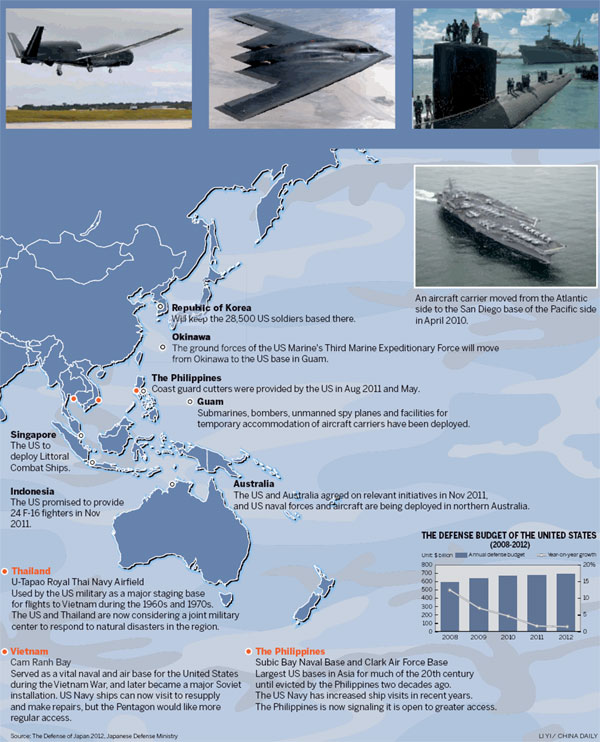US military swings to Asia-Pacific region
 0 Comment(s)
0 Comment(s) Print
Print E-mail China Daily, August 6, 2012
E-mail China Daily, August 6, 2012
Washington revised its military cooperation over the weekend with two of its major Asian allies as part of a revamp of its Asia strategy, that analysts said are aimed at curbing China.

The United States and Japan agreed on a proposed second revision of the Guidelines for Japan-US Defense Cooperation during Japanese Defense Minister Satoshi Morimoto's trip to Washington on Friday.
Morimoto met with his US counterpart Leon Panetta on Aug 3 to exchange views on the Guidelines, a document released in 1978 and first revised in 1997. The chiefs have agreed to initiate relevant discussions.
Yet some believe the revised plan is aimed at reining in China, and preparing for unexpected incidents in the East China Sea, Japan's leading newspaper Sankei Shimbun said.
Both defense chiefs agreed that the big picture of security in the region has changed since 1997 due to China's growing maritime presence and Pyongyang's nuclear plans, Japan's Jiji Press News Agency said.
Panetta has been advocating for Tokyo to deploy Osprey military aircraft to the US base in Okinawa, Japan, despite previous air crashes. Japanese Foreign Minister Koichiro Gemba said in late July that China's presence in the ocean is "obvious" and the deployment of Osprey military aircraft to Okinawa will help boost Tokyo's defense.
Japan's armed forces on Thursday also announced plans for a joint military drill with US forces in Okinawa later this month, Kyodo News Agency said.
The news agency quoted a spokesman for the six-day drill, planned to start on Aug 21, as saying that the exercise is aimed at "strengthening defense capabilities to guard islands", and is not planned to run counter to "any specific nation states".
Meanwhile, Yonhap News Agency on Sunday said Seoul and Washington are in talks to create a new joint military operation body as both sides agreed to dissolve the ROK-US Combined Forces Command, and Seoul plans to retake wartime operational control of its troops from the US in 2015.
The CFC has served as a command structure for the joint operation of military forces of the two allies since the 1950-53 Korean War. Seoul handed over control to the US shortly after the start of the war.
As the Obama administration gradually implements its Asia-Pacific strategy, the US armed forces are considering a return to some bases in Southeast Asia to extend its reach in the region.
The Pentagon has intensified discussions with Thailand about creating a regional disaster relief hub at an American-built airfield that housed B-52 bombers during the 1960s and 1970s.
In June, Panetta also visited Vietnam's naval and air base at Cam Ranh Bay, making him the highest-ranking US military official to do so since the end of the Vietnam War. The defense minister hailed the promising prospect of US ships again becoming a common sight at the deep-water port.
The US armed forces are also seeking a greater presence in the Philippines, including at the Subic Bay naval base and the former Clark Air Base, once the largest US military installation in Asia, as well as a key repair and supply hub during the Vietnam War.
Washington has been forging closer military ties with countries in the region and has announced that 60 percent of the US Navy's fleet will be based in the Asia-Pacific by 2020, up from less than 55 percent at present.
Currently, the US fleet is almost evenly split between the Atlantic and Pacific oceans.
Meanwhile, the Pentagon has sped up moves to reshuffle the military chiefs in charge of the region, as General Herbert Carlisle officially took office on Friday as the new commander of the US Command of Pacific Air Forces.






Go to Forum >>0 Comment(s)